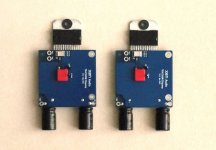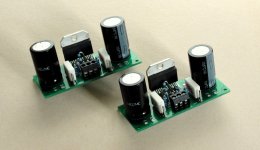I am looking to build an amplifier for a pair of Fostex BK-40h fullrange desktop speakers. Initially, I was just going to buy a dayton DTA-1 but that's boring.
I am considering building the non-inverting gainclone described here on some perfboard as it is very simple and does not seem to require a lot of heat dissipation. Are there any other amp designs or gainclone variations that I should consider?
Thanks.
I am considering building the non-inverting gainclone described here on some perfboard as it is very simple and does not seem to require a lot of heat dissipation. Are there any other amp designs or gainclone variations that I should consider?
Thanks.
An LM1876 (or LM4766) would seem more than sufficient for a pair of speakers rated 6 W with a following wind. I'd look for a good, proven layout for one of these or another similar IC. Layout is highly critical in power amplifiers. Even a job geared more towards car audio may well get the job done, assuming noise isn't too excessive... we are talking 8 ohm speakers rated 78 dB / W / m, so not the very most sensitive either. Should be better than a TDA2822(M), but I imagine that 300 µV of output noise should be tolerable.
You could also use TDA1517 or TI's TPA1517 running at just slightly below max. rated supply voltage. These chips are extremely easy to implement.
Another easy amp is a TDA2616; but you would implement it at a lower supply voltage of cca +/-10V to +/-12V to bring the output down to your speakers' power handling ability.
Another easy amp is a TDA2616; but you would implement it at a lower supply voltage of cca +/-10V to +/-12V to bring the output down to your speakers' power handling ability.
hard not to recommend one of these for $4. A TDA7293 mono board and a simple 12-18V (center-tap) transformer, you are up and running. Super simple, and sounds pretty good (running a pair in my garage currently at 24Vac).
TDA7293 AC12V-32V 100W l Audio Amplifier Mono Single Channel Board | eBay
TDA7293 AC12V-32V 100W l Audio Amplifier Mono Single Channel Board | eBay
Your suggestion is well meant but dated.tda2030, tda2050........same 5 pin layout as lm1875 -
and cheap......
TDA2050 has disappeared from the market for years.
TDA2030 is nominally available but only second source suppliers.
Both are widely available as FAKES of course.
LM1875 is alive, well, and available from original manufcturer.
While we are totally happy with our bridged LM1876 for our Mini DCAAV :
Mini DCAAV with Dayton ND91 ?
we also want to try something simpler.
The TDA7266M is a good tip.
So we went ahead to make a pair.
Mini DCAAV with Dayton ND91 ?
Totally easy. Both channels done in less than 30 minutes.
Works first time. Sounds good.
Can run from a 12V 24W SMPS per channel with ease.

Patrick
.
Mini DCAAV with Dayton ND91 ?
we also want to try something simpler.
The TDA7266M is a good tip.
So we went ahead to make a pair.
Mini DCAAV with Dayton ND91 ?
Totally easy. Both channels done in less than 30 minutes.
Works first time. Sounds good.
Can run from a 12V 24W SMPS per channel with ease.
Patrick
.
Attachments
Is low-level high-frequency distortion really as bad as the datasheet suggests though (which would mean major crossover distortion / substantially underbiased output stage), or is that just a measurement artifact caused by it actually being a THD+N measurement with higher bandwidth? Otherwise, gain of 26 dB and 150 µV of output noise seem sensible enough, and it'll make a few watts which is probably adequate (it's probably wise to choose an input coupling cap according to the speakers driven, and perhaps even consider a 2nd-order highpass).
Distortion is pretty much the same as the its brother TDA7297.
Iq is 50mA, so not a lot compared to say LM1875.
I agree it is probably not the best chipamp around.
But the big brother TDA7297 has a lot of followers :
What the heck? It's less than lunch!
Complete chip amp kit with enclosure, etc ?
And it is just so simple compared to say our bridged LM1876.
It can take very low voltage (well belos 18V), which the LM18xx cannot.
Ideal for DIY beginners & computer speakers, I would say.
Patrick
Iq is 50mA, so not a lot compared to say LM1875.
I agree it is probably not the best chipamp around.
But the big brother TDA7297 has a lot of followers :
What the heck? It's less than lunch!
Complete chip amp kit with enclosure, etc ?
And it is just so simple compared to say our bridged LM1876.
It can take very low voltage (well belos 18V), which the LM18xx cannot.
Ideal for DIY beginners & computer speakers, I would say.
Patrick
Here a 6283 kit is available, 1.5 watts per channel or so off 12 volts, populated PCB is about 50 Rupees, the chip alone is 25 or so for Kia (Korean).
The kit has a cheaper Chinese chip.
It is used a lot in FM radios
Stereo, the FM radios use only one channel, and it is loud enough for a 4 in speaker in a decent sized room from a single speaker in an FM radio.
Somehow, I am not able to load the images...you can search for "6283 kit"
The kit has a cheaper Chinese chip.
It is used a lot in FM radios
Stereo, the FM radios use only one channel, and it is loud enough for a 4 in speaker in a decent sized room from a single speaker in an FM radio.
Somehow, I am not able to load the images...you can search for "6283 kit"
Last edited:
Kia is not likely to make fake chips, those are licensed copies due to evolution at the original maker, as volumes or prices drop, and requirements change, the chips go out of production, and are made elsewhere.
Anyway, ST offers chips from 3 volts and 800 mW on wards, take your pick.
So do other Western makers, and there might be a few Japanese suppliers like Matsushita and NEC too.
Keep us posted.
Anyway, ST offers chips from 3 volts and 800 mW on wards, take your pick.
So do other Western makers, and there might be a few Japanese suppliers like Matsushita and NEC too.
Keep us posted.
GOOD!!!
Only problem, and not your fault, just checked Mouser for reference:



Only problem, and not your fault, just checked Mouser for reference:
In Stock: 11
Stock:
11
Can Ship Immediately
On Order:
1,160
Expected 6/16/2022
440
Expected 1/25/2023
How many would you need ?
192 pieces enough for you ?
https://de.rs-online.com/web/p/audioverstarker-ics/5343318
https://de.rs-online.com/web/p/audioverstarker-ics/1624743
Cheers,
Patrick
192 pieces enough for you ?
https://de.rs-online.com/web/p/audioverstarker-ics/5343318
https://de.rs-online.com/web/p/audioverstarker-ics/1624743
Cheers,
Patrick
And of course you can also use LM1876 :
https://eu.mouser.com/ProductDetail...ha2pyFadujyP7%2Bm/EUcoY7BnR2ghH/ILhGBTZHdXGU=
273 in stock.
Patrick
https://eu.mouser.com/ProductDetail...ha2pyFadujyP7%2Bm/EUcoY7BnR2ghH/ILhGBTZHdXGU=
273 in stock.
Patrick
- Home
- Amplifiers
- Chip Amps
- Chip Amp For computer speakers

